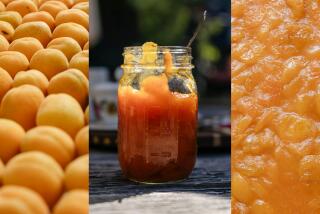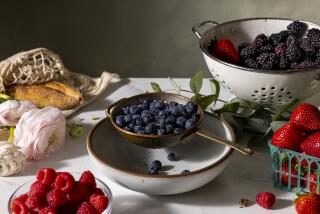JAMMIN’ Like Grandma
- Share via
IT ALL STARTED WITH THE STRAWBERRIES--with this season’s bounteous crop, red and juicy, heaped high in quart containers at fire-sale prices. I wanted to buy them by the flat, these sweet fruits of summer’s sun, to honor them, immortalize them. And, yes, to preserve them. I was determined, at last, to overcome my fear of jamming.
“Oh, forget it,” said the saleslady at the upscale cooking-supply store that I’d sauntered into, assuming they’d have everything I needed to proceed--canning tongs, a nine-quart nonreactive pot, a rack to keep the jars from touching the bottom of the pot, the jars and lids, a ladle, a canning funnel and lots of clean towels. “Don’t go to the trouble,” she said. “We sell jams that are better than homemade.”
But I wanted to go to the trouble. After a day of driving, asking, looking and driving farther, I found everything in a series of garden and hardware stores. When I finally got home with my equipment, I felt like an old-fashioned canning fool as I grabbed each Mason jar with my specialized canning tongs, plunging it into boiling water to sterilize. (Do this according to the directions on the box of jars, which I do not feel compelled to repeat here.) I prepped the berries, put them in a pot and stirred. They gave off juice. I added sugar. The mixture began to boil.
And I ignored my intuition. I hadn’t spent summers with a grandmother who “put up” cucumbers, beach plums or berries. I was a victim of a recipe called “Strawberry Jam 101” that I had pulled from a fancy food magazine. As I boiled and stirred, the jam seemed to be jamming. It even passed the jell test, whereby you spoon some of the syrup onto a chilled plate, return it to the freezer for a minute, and if it begins to jell, it’s jam. I wanted to take it off the heat, but the thermometer read 10 degrees below the called-for temperature. And so I resisted temptation and stirred on until I had a thick, brownish-red mixture, which turned out to have the undertones of burnt caramel that render a jam unsalvageable--an occurrence one recipe I came across later warned about.
Yet I continued experimenting with batch after batch, from recipe after recipe, in an effort to teach myself what that grandmother might have imparted to me in one summer afternoon. The variables of jam-making include, simply, cooking time, sugar content and the thing around which jam turns: pectin. Fruits naturally contain different amounts of pectin. Underripe fruit contains more. Pectin is brought out by cooking and reacts to sugar. (Pectin also comes in boxes, but I wasn’t about to stoop so low.) After the seventh and last batch, which came out pretty tasty, I had to admit that this endeavor has nothing to do with immortalizing the sweet fruits of summer’s sun. It has to do with the process of the process. It has to do with mastering a difficult form. It has to do with purity.
NOT-TOO-SWEET STRAWBERRY JAM
Makes 3 pints
Make sure to have equipment ready before buying your fruit.
8 cups strawberries, not too ripe, hulled and halved
4 cups sugar
Juice of 2 lemons (about 1/3 cup)
3 or 4 small plates, chilled in freezer
3 1-pint or 6 half-pint Mason jars
Sterilize jars according to instructions on Ball Mason Jar box (see Resource Guide). Place jars and lids in hot water until ready to use. Place prepared strawberries in nine-quart nonreactive pot. Simmer over medium heat for about 10 minutes, while berries release juice. Add lemon juice and cook another 5 minutes. Add sugar, stirring until one cup is dissolved before adding next. Bring mixture to boil. It will foam and rise up. Lower heat to boil, but not to rising. Meanwhile, with stainless steel spoon, skim off foam. Boil 10 to 20 minutes. As mixture begins to thicken, stir constantly, taking care not to scald. Total cooking time will be about 45 to 50 minutes. Jam is done when a spoonful dropped on chilled plate and returned to freezer for one minute begins to jell. Repeat every 2 minutes until it passes jell test. Remove from heat.
Using tongs, remove jars from boiling water and invert onto kitchen towel. Turn jars over and ladle jam into jars, using canning funnel, leaving 1/4-inch space at the top. With paper or towel dipped in hot water, wipe off inside rim. Remove lids from boiling water, place screw-bands on tightly. To seal, set jars back in water, boil 10 minutes, remove and cool on a cooling rack. In 24 hours, test seal by pressing on center of lid; if it does not flex, it is sealed and you can store jam in a cool, dark place for up to a year. If the lid does flex, the seal didn’t “take.” Use this like any opened jam jar: stored in the refrigerator.
More to Read
Eat your way across L.A.
Get our weekly Tasting Notes newsletter for reviews, news and more.
You may occasionally receive promotional content from the Los Angeles Times.










